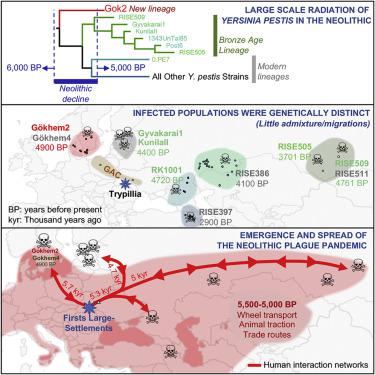Our official English website, www.x-mol.net, welcomes your
feedback! (Note: you will need to create a separate account there.)
Emergence and Spread of Basal Lineages of Yersinia pestis during the Neolithic Decline.
Cell ( IF 45.5 ) Pub Date : 2018-Dec-05 , DOI: 10.1016/j.cell.2018.11.005 Nicolás Rascovan , Karl-Göran Sjögren , Kristian Kristiansen , Rasmus Nielsen , Eske Willerslev , Christelle Desnues , Simon Rasmussen
Cell ( IF 45.5 ) Pub Date : 2018-Dec-05 , DOI: 10.1016/j.cell.2018.11.005 Nicolás Rascovan , Karl-Göran Sjögren , Kristian Kristiansen , Rasmus Nielsen , Eske Willerslev , Christelle Desnues , Simon Rasmussen

|
Between 5,000 and 6,000 years ago, many Neolithic societies declined throughout western Eurasia due to a combination of factors that are still largely debated. Here, we report the discovery and genome reconstruction of Yersiniapestis, the etiological agent of plague, in Neolithic farmers in Sweden, pre-dating and basal to all modern and ancient known strains of this pathogen. We investigated the history of this strain by combining phylogenetic and molecular clock analyses of the bacterial genome, detailed archaeological information, and genomic analyses from infected individuals and hundreds of ancient human samples across Eurasia. These analyses revealed that multiple and independent lineages of Y. pestis branched and expanded across Eurasia during the Neolithic decline, spreading most likely through early trade networks rather than massive human migrations. Our results are consistent with the existence of a prehistoric plague pandemic that likely contributed to the decay of Neolithic populations in Europe.
中文翻译:

新石器时代衰落期间鼠疫耶尔森氏菌基底谱系的出现和传播。
在5,000至6,000年前,由于各种因素的综合讨论,许多新石器时代的社会在整个欧亚大陆都衰落了。在这里,我们报道了鼠疫的病原体耶尔森氏菌在瑞典新石器时代的农民中的发现和基因组重建,该病史早于该病原体,并且已经存在于该病的所有现代和古代已知菌株中。我们通过对细菌基因组的系统发育和分子钟分析,详细的考古学信息以及来自整个欧亚大陆的受感染个体和数百个古代人类样品的基因组分析相结合,研究了该菌株的历史。这些分析表明,新石器时代的衰落期间,鼠疫耶尔森氏菌的多个独立系在欧亚大陆分支并扩展,最有可能通过早期贸易网络传播,而不是大规模的人口迁移。我们的结果与史前瘟疫大流行的存在相一致,该大流行可能导致了欧洲新石器时代人口的减少。
更新日期:2018-12-07
中文翻译:

新石器时代衰落期间鼠疫耶尔森氏菌基底谱系的出现和传播。
在5,000至6,000年前,由于各种因素的综合讨论,许多新石器时代的社会在整个欧亚大陆都衰落了。在这里,我们报道了鼠疫的病原体耶尔森氏菌在瑞典新石器时代的农民中的发现和基因组重建,该病史早于该病原体,并且已经存在于该病的所有现代和古代已知菌株中。我们通过对细菌基因组的系统发育和分子钟分析,详细的考古学信息以及来自整个欧亚大陆的受感染个体和数百个古代人类样品的基因组分析相结合,研究了该菌株的历史。这些分析表明,新石器时代的衰落期间,鼠疫耶尔森氏菌的多个独立系在欧亚大陆分支并扩展,最有可能通过早期贸易网络传播,而不是大规模的人口迁移。我们的结果与史前瘟疫大流行的存在相一致,该大流行可能导致了欧洲新石器时代人口的减少。











































 京公网安备 11010802027423号
京公网安备 11010802027423号